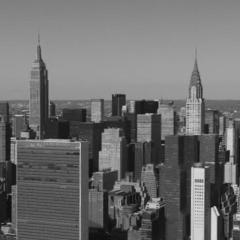 Earlier we learned a little about John Raskob and the fortune he made with Billy Durant and last time we learned about another GM alumnus, Walter Chrysler. Raskob and Chrysler knew each other, because both were part of General Motors’ top leadership after Billy completed his comeback. But, like most successful people, they had more than a little competitiveness in them toward each other, which would play out in…
Earlier we learned a little about John Raskob and the fortune he made with Billy Durant and last time we learned about another GM alumnus, Walter Chrysler. Raskob and Chrysler knew each other, because both were part of General Motors’ top leadership after Billy completed his comeback. But, like most successful people, they had more than a little competitiveness in them toward each other, which would play out in…
The Race For The Sky
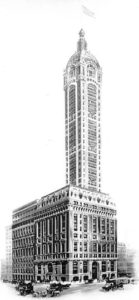
What’s the first image that comes to mind when you hear New York? The Manhattan skyline most likely. Today we take it for granted, but it wasn’t always like that. The dawn of the twentieth century heralded an era of new records, new inventions and new achievements like radio, electricity, record players and the telephone. In 1903 the Wright brothers flew and the Curved Dash Oldsmobile created a new industry. It was a heady time. Mankind was reaching for the sky.
It started innocently enough in Manhattan when the Singer sewing machine company wanted to build a new headquarters building. Why not reach for the sky? As you can see from the image, it had a “normal” building at its base and what looked like a tower on top.

The press went bananas. At 600 feet, it was the tallest building in the world.
For about a year.
Because the Metropolitan Life Insurance Company thought hmm… what a terrific idea to gain publicity as a world leader. So they commissioned a higher building. The bar was set at 700 feet.
To their credit, they did indeed use the building as an anchor in their advertising; it wasn’t just an expression of an oversized ego.
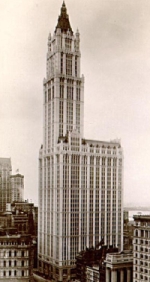
Frank Woolworth was sitting atop an empire of five-and-dime stores. In today’s terms that would be like Dollar General and Family Dollar. Like that famous lady from the South recently remarked: “I don’t need to dress up to got to Family Dollar. It’s not like I’m going to Walmart or something.” In other words, his empire was not Nordstrom or something like that. One can therefore understand his desire to express class in some way. He chose a Manhattan skyscraper, and not just any old.
He was in the planning stages of a new headquarters building. It was a (now) modest 420 feet. When he saw the brouhaha surrounding the worlds-tallest buildings he instructed the architect to double his building. It was completed in 1913 and came in just under 800 feet.
It’s interesting to note the human trait of copy-catting. The Singer building had a conventional “base” building with a tower on top, almost like an Italian campanile. Look how the others followed the same pattern. (That, incidentally, is when tall buildings began to be called towers, even though their shape later bore no resemblance to those earlier towers.)
The First World War brought a temporary halt to the race to the sky. However, as the economy recovered and raced into the Roaring Twenties, Men With Wallets began casting their eyes to the skies. Jazz musicians began calling New York the Big Apple in reference to what gigs paid there, as opposed smaller towns which paid smaller apples.
In 1928 the Big Apple saw 760 new buildings stretch upward, at a cost of over $250 million. Their plans for 1929 totaled almost double that. Why gamble with the fickle stock market when you can invest in real estate which will never disappear? Men with egos and architects boasted of their next tower to one another. The Manhattan Bank (since then morphed into Chase Manhattan and today a forgotten part of JPM Chase) set the bar with their new building at 40 Wall Street.
The Chrysler Building
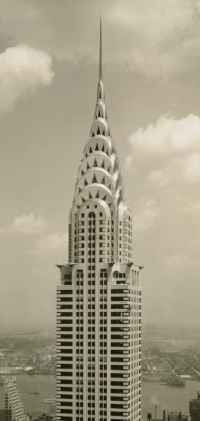
Walter Chrysler had been looking for a real estate investment, as we saw last time. When someone else’s 1921 plan to build a skyscraper on 42nd and Lexington fell into bankruptcy, Chrysler pounced. He kept the architect, but insisted on reshaping the top with a more artistic touch… and to reach exactly 16 feet higher than the Woolworth building. No rocket science was needed to figure out that 16 feet was just ego.
George L. Ohrstrom, force behind the Manhattan Bank building heard about it and upped his design to 840 feet, to beat Chrysler by 32 feet. The bidding war was on. Chrysler had his architect add some height and crowed about his building going to be the tallest.
John Raskob, meanwhile, decided he didn’t need to be outdone by Chrysler. He acquired the Waldorf-Astoria hotel and proposed to raze it and erect the highest building on earth there.
Ohrstrom raised the 40 Wall Street building specs and triumphed with 925 feet in April of 1929. He would win. Or so everyone thought. Rather than wage the ego battle in announcements, Chrysler decided to let it ride.
On October 23, 1929, the day before the great market crash, Chrysler and his architect stunned the world when they hoisted up a secretly constructed spire and placed it atop the Chrysler building, making it the tallest building in the world, the first one over 1,000 feet. (The building at 40 Wall Street today is called the Trump Tower.)
The Empire State Building
Raskob followed everything in the press and instructed his architect to leave no room for error. His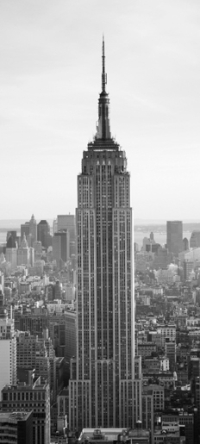 building had to be the highest by a good margin, removing the temptation for the others to add fanciful bits to top his building. Sure enough, when the Empire State building was completed, it stood almost 50% taller than the Chrysler building.
building had to be the highest by a good margin, removing the temptation for the others to add fanciful bits to top his building. Sure enough, when the Empire State building was completed, it stood almost 50% taller than the Chrysler building.
Both Chrysler and Raskob had Billy Durant to thank for the bulk of their fortunes which funded New York’s two skyline icons. As for Billy, he never cared for monuments. He never even bothered with the mansions so beloved of the wealthy. It was only after the great comeback that his wife prevailed and he bought Raymere, but even that was ‘average’ as far as those things go.
Ironically, Walter Chrysler had the last laugh in the race to sky. Because the Chrysler building was completed earlier, and was closer to Grand Central station, it was more successful as a real estate investment from the get-go.
The Empire State building took decades before it got dethroned as New York’s tallest, partly because it brought such a giant leap, and partly because it opened at the height of the Great Depression and took several decades to fill up with tenants.
Both towers have stood the test of time well. One can only hope his company will do the same…